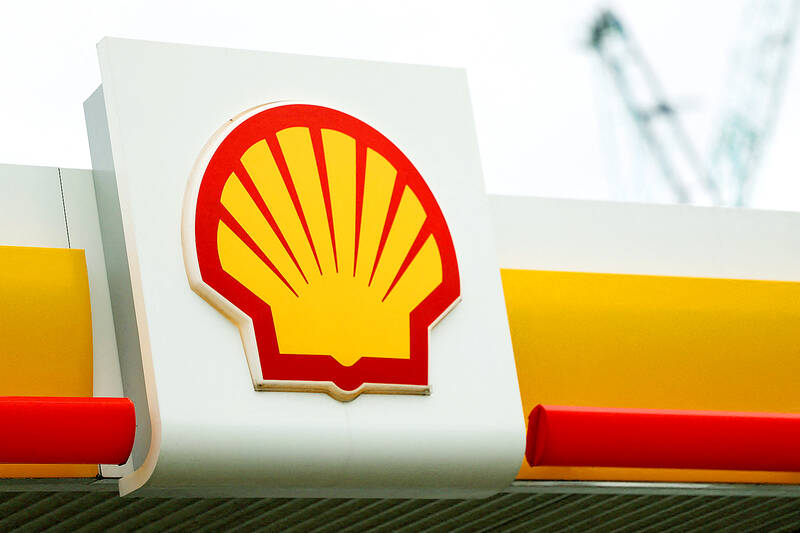Shell PLC plans to increase its dividend 15 percent and boost natural gas production as new CEO Wael Sawan refocuses on the fossil fuels that drove record profits last year.
It is part of a pivot by the European oil major to expand the most profitable parts of its business, even if they are carbon intensive, while scaling back ventures that do not make high enough returns.
The company reiterated its pledge to achieve net zero emissions by 2050.

Photo: Reuters
“We will invest in the models that work — those with the highest returns that play to our strengths,” Sawan said in a statement.
The management team was scheduled to lay out more details of the plan to shareholders at a presentation in New York yesterday.
The company has been gradually building back its dividend since former Shell CEO Ben van Beurden cut it during the depths of the COVID-19 pandemic. While the latest increase would still leave the payout about 30 percent below pre-pandemic levels, the move might help convince investors that the company can be a reliable source of cash, like its more highly valued US peers.
As well as the dividend increase, which would take effect this quarter, Shell committed to buying back at least US$5 billion of shares in the second half of this year. The company would reduce capital spending to US$22 billion to US$25 billion a year for next year and 2025, down from an expectation of US$23 billion to US$27 billion this year.
Key to achieving higher returns would be the oil and gas business that drives the majority of Shell’s profits. The company would no longer seek to cut oil production by 1 to 2 percent annually, having achieved its initial output-reduction plan — announced in 2021 amid a focus on cutting carbon emissions — faster than anticipated.
Shell aims to grow its integrated gas business and is to stabilize oil output to 2030. That follows in the footsteps of BP PLC, which also rolled back its plans to cut oil production earlier this year.
The initial outline of Shell’s plan puts oil and gas front and center while giving lower-return, low-carbon efforts a smaller supporting role. That is in stark contrast from the company’s strategy update about two years ago, when Shell said its oil production was in decline and named electricity and low-carbon hydrogen as its key sources of growth.
Shell said it is to invest “selectively” in power, focusing on markets where it can add value with its traders.
Investments in hydrogen and carbon capture technology would be made “in a disciplined manner to create options for the future,” it said.

Semiconductor business between Taiwan and the US is a “win-win” model for both sides given the high level of complementarity, the government said yesterday responding to tariff threats from US President Donald Trump. Home to the world’s largest contract chipmaker, Taiwan Semiconductor Manufacturing Co (TSMC, 台積電), Taiwan is a key link in the global technology supply chain for companies such as Apple Inc and Nvidia Corp. Trump said on Monday he plans to impose tariffs on imported chips, pharmaceuticals and steel in an effort to get the producers to make them in the US. “Taiwan and the US semiconductor and other technology industries

A start-up in Mexico is trying to help get a handle on one coastal city’s plastic waste problem by converting it into gasoline, diesel and other fuels. With less than 10 percent of the world’s plastics being recycled, Petgas’ idea is that rather than letting discarded plastic become waste, it can become productive again as fuel. Petgas developed a machine in the port city of Boca del Rio that uses pyrolysis, a thermodynamic process that heats plastics in the absence of oxygen, breaking it down to produce gasoline, diesel, kerosene, paraffin and coke. Petgas chief technology officer Carlos Parraguirre Diaz said that in

SMALL AND EFFICIENT: The Chinese AI app’s initial success has spurred worries in the US that its tech giants’ massive AI spending needs re-evaluation, a market strategist said Chinese artificial intelligence (AI) start-up DeepSeek’s (深度求索) eponymous AI assistant rocketed to the top of Apple Inc’s iPhone download charts, stirring doubts in Silicon Valley about the strength of the US’ technological dominance. The app’s underlying AI model is widely seen as competitive with OpenAI and Meta Platforms Inc’s latest. Its claim that it cost much less to train and develop triggered share moves across Asia’s supply chain. Chinese tech firms linked to DeepSeek, such as Iflytek Co (科大訊飛), surged yesterday, while chipmaking tool makers like Advantest Corp slumped on the potential threat to demand for Nvidia Corp’s AI accelerators. US stock

SUBSIDIES: The nominee for commerce secretary indicated the Trump administration wants to put its stamp on the plan, but not unravel it entirely US President Donald Trump’s pick to lead the agency in charge of a US$52 billion semiconductor subsidy program declined to give it unqualified support, raising questions about the disbursement of funds to companies like Intel Corp and Taiwan Semiconductor Manufacturing Co (台積電). “I can’t say that I can honor something I haven’t read,” Howard Lutnick, Trump’s nominee for commerce secretary, said of the binding CHIPS and Science Act awards in a confirmation hearing on Wednesday. “To the extent monies have been disbursed, I would commit to rigorously enforcing documents that have been signed by those companies to make sure we get